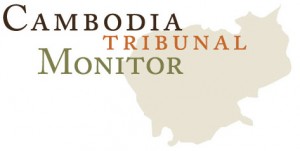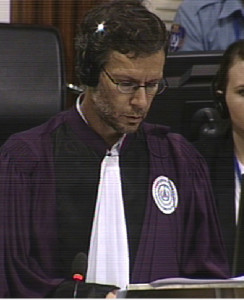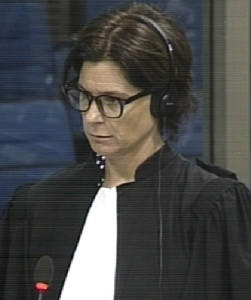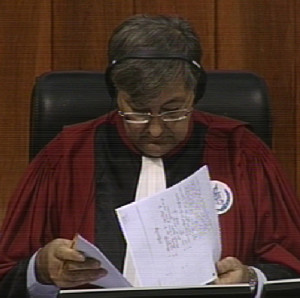Shedding Light on Lists of S-21 Prisoners: the Facts Between the Lines
The testimony of Suos Thy, former list-keeper at S-21, continues. Today, the parties sought to give substance to the sinisterly numerous and long records of names. The rapid pace of questioning in the morning illustrated the difficulties faced the day before, when the prosecution had asked for more time to go through additional issues and documents with the witness. The Civil Party Lawyers then asked a series of questions about the Vietnamese families arriving at S-21, and also referred to previous incriminating testimonies in relation to alleged instances of rape. Mr. Suos Thy denied ever witnessing such abuses. Judge Jean-Marc Lavergne ended the day by a tortuous line of questioning, which revealed more about the functioning of S-21, including the classification of prisoners.
Prosecution carries on: what S-21 lists reveal
The President introduced the witness once again, and gave the floor to Senior Assistant Co-Prosecutor Vincent de Wilde. Mr. de Wilde started by presenting three 1978 document to the witness, which were lists of prisoners coming in S-21, drafted by the witness. In the first document, it was question of the S-71 office, which the witness said he knew nothing about.[1] In the list from the second document, Mr. de Wilde inquired about the Vietnamese names.[2] Questions about a 14-year-old Vietnamese girl led the witness to confirm that the names of children were only recorded when they were older than 15 or if they came without their families. Mr. de Wilde then proceeded to ask whether the witness remembered if the other Vietnamese farmers on the list were arrested by soldiers from the Southwest region in Vietnam or if they were Vietnamese farmers arrested in the territory of Democratic Kampuchea, but the witness did not remember. The third document[3] was a list on which figured many high-ranked officials[4], and when Mr. de Wilde inquired as to why they had all arrived on the same day (as indicated by the document), the witness was not able to provide an answer.
Prison conditions at S-21
Answering Mr. de Wilde’s questions about S-21 prisoners, the witness said that individuals arrived in shackles at the facility and kept them on even when they went to sleep. When he was passing by, the witness indicated that he could smell the stench emanating from the cells, where prisoners lived and had to relieve themselves. When asked about the general health of the prisoners, Mr. Suos Thy said without hesitation that they were all emaciated and extremely frail because they did not get enough to eat. Mr. Suos Thy was in charge of updating his records thanks to reports from the medical staff that he received from his superior, Hor, which meant that he was aware of the causes of death of the deceased prisoners. Mr. de Wilde referred to the witness’ 2009 testimony[5] and wanted to know if he confirmed his statement that some prisoners were recorded as having died of illness, even if they had actually died from torture. Mr. Suos Thy did not confirm or deny this statement, simply stating several times that he only copied information from the reports from the medical staff.
Continuing his line of questioning, Mr. de Wilde referred to a list of prisoners who died of illness and prisoners who were executed[6]. He took an example on the list, quoting the cause of death for a prisoner as being “bruised – numb” and asked the witness if he recalled ever seeing lists of this kind. The witness said he did not draft report of this nature but clarified that these two terms referred to injuries related to torture: “numb” meant “swollen”. Pointing out that on a period of two weeks, about 40 people on that list were marked as deceased due to illness or torture, Mr. de Wilde asked the witness if he knew if these figures could be considered like normal on average. Mr. Suos Thy declared he was not aware of the total number of victims, but according to his estimations, around one person died each day at S-21.
It was clear that many of the questions asked by the Co-Prosecutor relied on Mr. Suos Thy’s testimony from nearly seven years ago. After an inconclusive answer to an open question about blood draws on S-21 prisoners, Mr. de Wilde quoted the witness himself, who testified in 2009 that he knew blood draws were being performed on prisoners, that Hor ordered him to gather the information from the medical reports and then mark these individuals as ones that were to be executed.[7] Mr. Wilde inquired why that was, before Mr. Victor Koppe, Co-Counsel for the Defense of Nuon Chea, interjected and said these questions were leading the witness. Mr. de Wilde rephrased his question, to which Mr. Suos Thy answered that only Hor gave the names of the ones from which blood was taken, which he recorded in the list of people that were to be executed (list similar as the one shown by Mr. de Wilde[8]).
Moving on, Mr. de Wilde referred to Hor’s notes on the list, namely of the word “kom” (previously also spelled as “komchat”) next to some of the prisoners, meaning they were to be executed. He relied once more on a 2009 statement by the witness, which specified that he had a role in verifying the records of prisoners who had been executed.[9] Mr. Suos Thy, however, denied he was ever notified that prisoners had been executed after they were taken away, and referred instead to the “Unit of the 100 Men” who were the ones who took the prisoners away and reported to Hor.
The Vietnamese prisoners
The Co-Prosecutor then shifted his focus to the Vietnamese prisoners who entered S-21. The witness confirmed that they were both civilians and members of the military, often arrived with their families and included people fleeing the country as well as fishermen arrested at sea. In a 2009 interview, the witness set out he knew about some Vietnamese nationals fleeing towards Thailand, which he recalled. However, he did not know about confessions of Vietnamese nationals being broadcasted on the radio that Mr. de Wilde made reference to.[10]
Phan alias Chan, the interpreter who helped Mr. Thy with the arriving Vietnamese nationals, affirmed in an interview[11] that these prisoners had to “confess to being spies” or they would be “beaten to death” by Mam Nai alias Chan. Many were afraid and complied “in writing”, “on the record” and their picture was taken in a military uniform. The witness did not recall this.
Period preceding the fall of the regime
The period between December 1978 and January 1979 was a challenging time for the Party leaders, as the regime was about to fall. Mr. de Wilde inquired about how this was dealt with at S-21: were there any instructions by Kaing Guek Eav, alias Duch, to execute all the S-21 prisoners except for the ones who worked there? Was it evident from your records? The witness only answered by referring to his chain of command. A list from December 31, 1978 enumerating 225 prisoners that were to be executed was brought forward was qualified by the witness as being the last list of prisoners who had to be “smashed”.[12]
Civil parties forge ahead and tackle rape at S-21
Mr. Koppe from the Defense team took the floor for an introductory remark. As to a translation that was just given to the parties today[13], Mr. Koppe made clear that they have not had enough time to review it properly. In response, Civil Party Lead Co-Lawyer Marie Guiraud pointed out to Mr. Koppe that the defense had not opposed the OCIJ documents underlying the list when they were admitted to the Court, from which it was transparent that some were only available in Khmer.
Vietnamese families and subordination at S-21
Deploring the lack of time, Ms. Guiraud started a straight line of questioning aiming at getting more information about the recording process. She started by asking the witness how he would write down the names of the incoming prisoners, to which he answered he wrote them individually according to what he heard, not keeping written track of family and marital ties. According to him, the Vietnamese families were usually the ones fleeing their country.
Ms. Guiraud went on to ask about the young translator, Lann, who was 14 to 15 years old according to the witness’ statement the previous day. She sought to clarify his age, as in a previous interview, Mr. Suos Thy had given a younger age to his translator. He confirmed he had only given an estimate.[14]
Though Ms. Guiraud referred to an interview implying Mr. Suos Thy carried out more than he said, the witness denied he ever did anything that was not a direct order from Hor, including allowing prisoners to work outside.[15]
Sexual assault at S-21
When asked, the witness did not know anything about any cases in which women were raped by S-21 personnel. Knowing where she stood, Ms. Guiraud read an excerpt of a testimony from earlier this year[16], mentioning very clearly that a young guard (12-14 years old) had raped a prisoner. According to this same testimony, the incident was then mentioned in one of the training sessions, and the witness even said that Mr. Suos Thy knew the name of the alleged rapist. Answering to a pressing Ms. Guiraud, Mr. Suos Thy said he knew nothing about this.
“You have no recollection whatsoever? A young boy committed a rape, a young boy you knew?”, insisted Ms. Guiraud.
“If I knew, I would tell you,” answered the witness.
He gave the same response when asked about a second incident involving a certain guard named Touch[17], who allegedly raped a prisoner and then jumped from a building or attempted to do so. The Defense interjected nervously, asking for clarification as to the number of incidents referred to. Ms. Guiraud then went on to talk about two other alleged sexual assaults. The first one involved a nurse from the medical team, called Soeung, and the second one a guard named Chhoy who fled to Vietnam after being accused of misbehaving. The witness did not remember anything about these incidents either.
Judge Jean-Marc Lavergne paints the witness’ family picture
Judge Lavergne asked some follow-up questions to the witness, referring to his statements both from June 2, 2016 and this morning. First making mention of his biography[18], the witness was asked to elaborate on why he said he could not be a member of the CPK because of his family history. He answered that because his family members lived under the Lon Nol regime, he was classified as “petite-bourgeoisie”.
Asked about details of his family, Mr. Suos Thy said that of his eight siblings, only he and his two younger sisters remained. Mr. Suos Thy then went on and said he had been educated in Phnom Penh and according to him, his knowledge made him useful to the regime. The fact that he was in the division that later became Division 703, from which many S-21 prisoners came, was a “bad element” in his biography. Mr. Suos Thy remembered: “I was constantly afraid while I worked at S-21. My chiefs were being arrested [. . .]. I was so desperate and feared I would be arrested [too].”
Raising the tension, Judge Lavergne asked: “Did this fear push you to be a zealous officer at S-21?” The witness answered he only tried working the best he could so that he wouldn’t be arrested or put under surveillance. He then talked about the fact that he was arrested in 1984 because he had been an officer at Tuol Sleng.
Judge Lavergne, relentless with details
The witness appeared to know very little about the supply system of S-21. While Judge Lavergne asked about the raw material that was used for shackles, vehicles, and other supplies, the witness was only able to say he deferred to Meng for any supplies he needed in his own job, like sheets of paper. According to the witness, the logistics department was part of the interrogation section, and only one person took care of it: Thuon, from S-21 B. He was also in charge of the food supply.
After a few negative answers, the witness recalled that the documentation service was part of the interrogation’s unit, unit also called the First Office, and led by Duch. The Judge seemed to want to hold on to an internal regulation on the surveillance of the enemies, which the witness knew nothing about.[19] Judge Lavergne would come back to it later, and focused instead on a record of incoming prisoners at S-21[20]. It had apparently been signed by the witness, who had no recollection of it, even after a fastidious process during which the Judge insisted heavily, though in vain, on the document.
Stop and frisk?
Moving on, the Judge shifted his interest to how the prisoners were presented to Mr. Suos Thy. The witness was not given any documents[21] related to the prisoners who came through his office.
Judge Lavergne asked the witness: “When prisoners arrived at S-21, were they searched?” and the witness answered that they were handcuffed, blindfolded but arrived with no possessions, as from what the witness understood, they had been searched when arrested. Leaning on the internal regulation cited above (see footnote 21), Judge Lavergne meticulously sought to determine whether prisoners were clothes when they appeared in front of the witness[22], leaving the audience with an unclear answer.
Getting to the focal point of his questioning, Judge Lavergne asked if the witness had ever seen bruises on some of the arriving prisoners, and if some were sent to medical services upon arrival, due to poor physical condition. Visibly frustrated by the lack of substantive answers the witness was able to provide, the Judge asked if the witness “ever looked at them while he was taking down their names”. Witness: “I wasn’t paying attention”.
The Judge then kept on asking logistics questions to which the witness was unable to answer properly. He described how he was not the one deciding which prisoners got which cell; the guards assigned them, and the witness then went to the cells to record the arrangements. Moving on, the witness was able to clarify that “smashed” and “removed”, words that figured on various lists, meant the same thing. Judge Lavergne then brought forward a document[23] which he described as detailing about 40 prisoners, almost exclusively female, who had the particularity of either being pregnant or having just given birth. As the Judge enumerated the details that figured on the list, like the name of the spouse, the number of children or the advancement of pregnancy, the audience held its breath, wondering what chilling detail the Judge was going to ask about. “One annotation [likely made by Duch] was not translated, could you read what is written here?”, and the witness answered: “smashed”.
Degree of involvement and chain of command of the witness
Judge Lavergne was determined to get a thorough account of what the witness knew about the documents he had under his eyes. First, the Judge pointed out specific mentions of “laziness” on a list of people who were “removed”[24] [25][26]. The first list figured a majority of women, but also included children, notably children as young as seven years old. The witness had no recollection of these documents, and would only say that he got such documents by Hor and that Duch had made the annotations.
In a different document referred to by the Judge[27], the witness was able to confirm a number of acronyms and clarify some classification terms. Most importantly, he stated that term “bandit” meant “deserters”, and that “spies” usually referred to the Vietnamese. The witness then said that when Vietnamese soldiers were arrested, they were considered spies and classified as such. Hor had ordered this practice. The Judge stated that many documents like this demonstrate the detailed monitoring of prisoners, including the “Die Angkar” documentary[28].
Aware that he was going over his time, Judge Lavergne questioned the witness on the last topics he was interested in. The witness confirmed that he was the one writing the biographies of the S- 21 Guards’ Unit but that Meng wrote the others. He had no knowledge of any personnel from S-21 going to work in other centers[29]. Lastly, the Judge was inquiring whether some propaganda films were shown during the training sessions. He showed part of the film “Cambodia Kampuchea”[30], in which men in a Vietnamese military uniform were walking, then filmed talking individually, with their heads down. Then, Pol Pot is giving a speech and people are cheering. The witness did not recall this film and did not recognized anyone he knew in it. The witness said that under the regime, the Vietnamese were treated like the enemy but denied there was any mention of the Vietnamese in the training sessions he had attended.
The President then adjourned the hearing. It will resume Monday, June, 6, 2016, at 9 am with the testimony of witness Suos Thy.
[1] E3/2242, at 00919925-26 (FR), 00021136 (KH).
[2] E3/2209, at 00087036-41 (KH), 00893763-68 (ENG), 00878332-37 (FR). Authenticated in E3/7466 in 2009 and in E3/7603
[3] E3/1955, at 0870415-20 (FR), 00183685-89 (ENG), 00021270-74 (KH).
[4] First, there is a list of four people on the first page coming from S-71, including the chiefs of K-8 and K-13 offices. The same day, the chief of K-4 arrived that same day; chiefs of offices K-17, K-12 and K-6. 29 people came from the Eastern zone.
[5] E3/7466.
[6] E3/3187, ERN 000008891-92 (ENG); 00874564-69 (KH).
[7] E3/7466.
[8] E3/2285, at 00009212 (KH) and 00873432 (EN).
[9] E3/7465.
[10] E3/9320: DC-Cam document, at 00909159 (EN), 00052000 (KH), 00280498 (FR).
[11] E3/2352, at 57”19
[12] E3/10455, at 01248066-083 (EN).
[13] E3/10455.
[14] Interview with DC-Cam, E3/9320, at 0028492 (FR), 00909153 (EN), 00052015 (KH).
[15] Witness Chum Mey testified on 19/04/2016 that “at the end [of my time at S-21], Suos Thy came to ask who came from ORussei and he told me that the next day, I would be allowed to work outside. He came the next day with clean clothes but still shackled me; I was taken outside to go repair sowing machines”.
[16] Him Huy, who testified on 5/05/2016, excerpt around 13h58.
[17] Witness Lach Mean, heard 26/04/2007, 10h16.
[18] E3/10570.
[19] E3/8386, at 00002637-2640 (KH), 00521631-34 (EN).
[20] E3/8763, at 00008084 (KH), 00182982 (EN).
[21] E3/10521, at 01180400-01180413 (KH), 01191483-95 (EN).
[22] 29/07/2009 hearing of the witness; 10h57; E3/7465: “came to my office, were to take off their clothes, only allowed to wear shorts. They could not take anything with them, except for their clothes” contradicting with E3/8386 (footnote 21): “they need to keep their clothes, if they try to take them off the clothes need to be taken away from them”.
Point 10 of §1: “during the surveillance, cadres and soldiers must frisk the prisoners all the time: 6 am, 11am, 6pm and 11pm.” Lavergne: “Did you ever witness such searches?” Witness: “I didn’t pay attention to the internal regulations.”
[23] E3/10166A.
[24] E3/2285, at 00009110-9111 (KH), 00873220-26 (EN).
[25] At 00009097-9098 (KH), 00873202-08 (EN).
[26] E3/3181, at 00784613 (EN).
[27] E3/8763, at 0008083 (KH), 00182980-81 (EN).
[28] E3/719R.
[29] Witness Chum Sey indicated that Mr. No, from S-21, came to work at Ho Kung Sen, brought with him some confessions. The witness did not know Mr. No.
[30] E3/2354R, at 13”29-13”40 (witness Him Huy said that a film was shown at a session, anniversary of the victory, so the Judge thought that maybe it was this one).
Featured Image: Witness Suos Thy (ECCC: Flickr)




[…] See Shedding Light on Lists of S-21 Prisoners: the Facts Between the Lines, The Cambodia Tribunal Monitor, June 3, […]
[…] See Shedding Light on Lists of S-21 Prisoners: the Facts Between the Lines, The Cambodia Tribunal Monitor, June 3, […]